BBE 1: Organizational Types, Functions, and Structure Report
VerifiedAdded on 2021/11/16
|14
|3609
|397
Report
AI Summary
This report provides an in-depth analysis of the business environment, focusing on organizational types, functions, and structures. It begins by defining different types of organizations, including public, private, and voluntary sectors, along with their purposes. The report then explores the size and scope of various organizations, such as small businesses, mid-market firms, and large enterprises, and their impact on business objectives and products/services. Three organizations are examined in detail: Vinatex Da Nang Joint Stock Company, Hanosimex - Hanoi Textile & Garment Joint Stock Corporation, and Zara. The analysis includes their products, services, vision, mission, business objectives, and legal structures. Furthermore, the report investigates the relationship between organizational functions, objectives, and structure, highlighting how these elements are interconnected. It also discusses the advantages and disadvantages of these interrelationships within a business context. The report offers valuable insights into the dynamics of the business environment and organizational management.
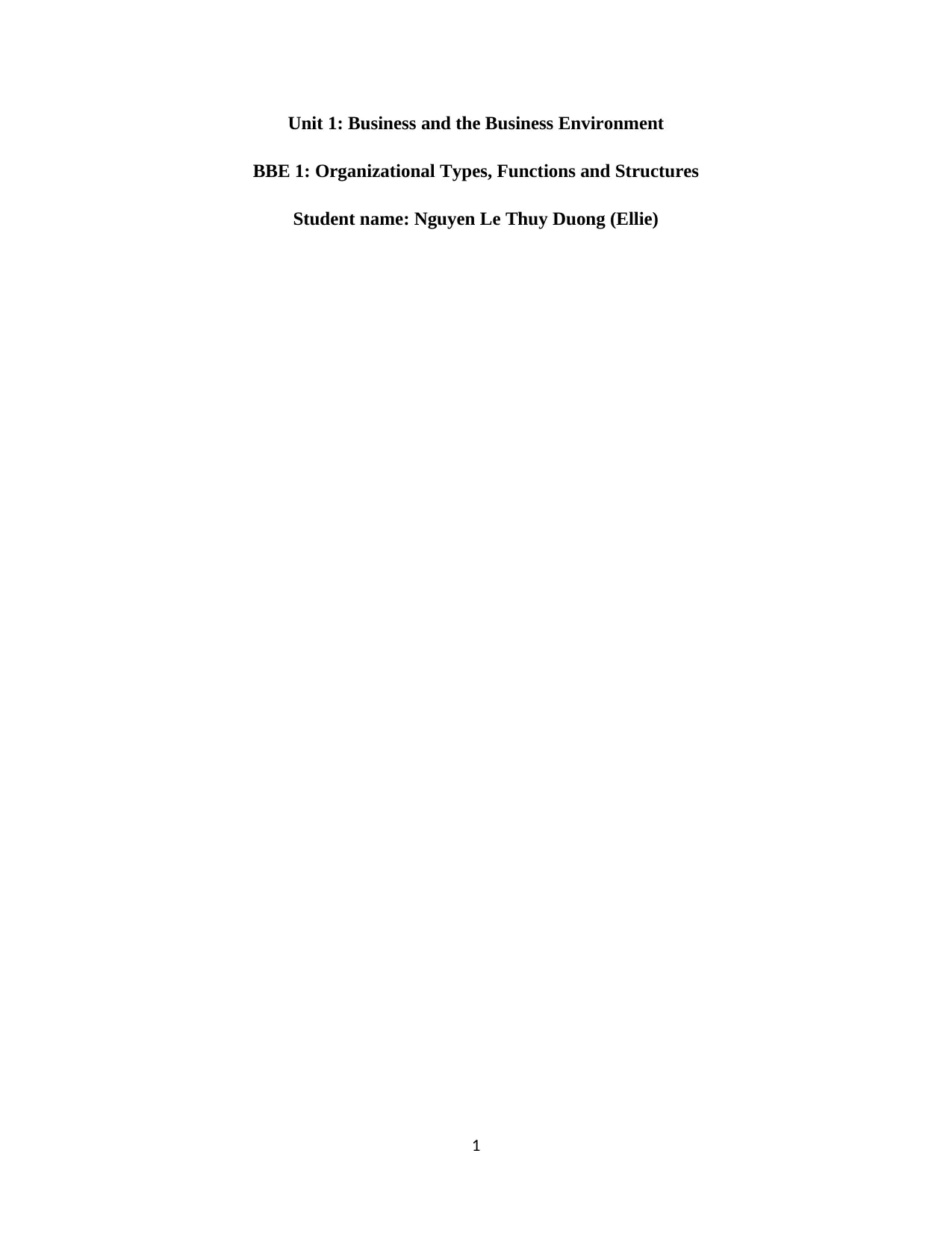
Unit 1: Business and the Business Environment
BBE 1: Organizational Types, Functions and Structures
Student name: Nguyen Le Thuy Duong (Ellie)
1
BBE 1: Organizational Types, Functions and Structures
Student name: Nguyen Le Thuy Duong (Ellie)
1
Paraphrase This Document
Need a fresh take? Get an instant paraphrase of this document with our AI Paraphraser
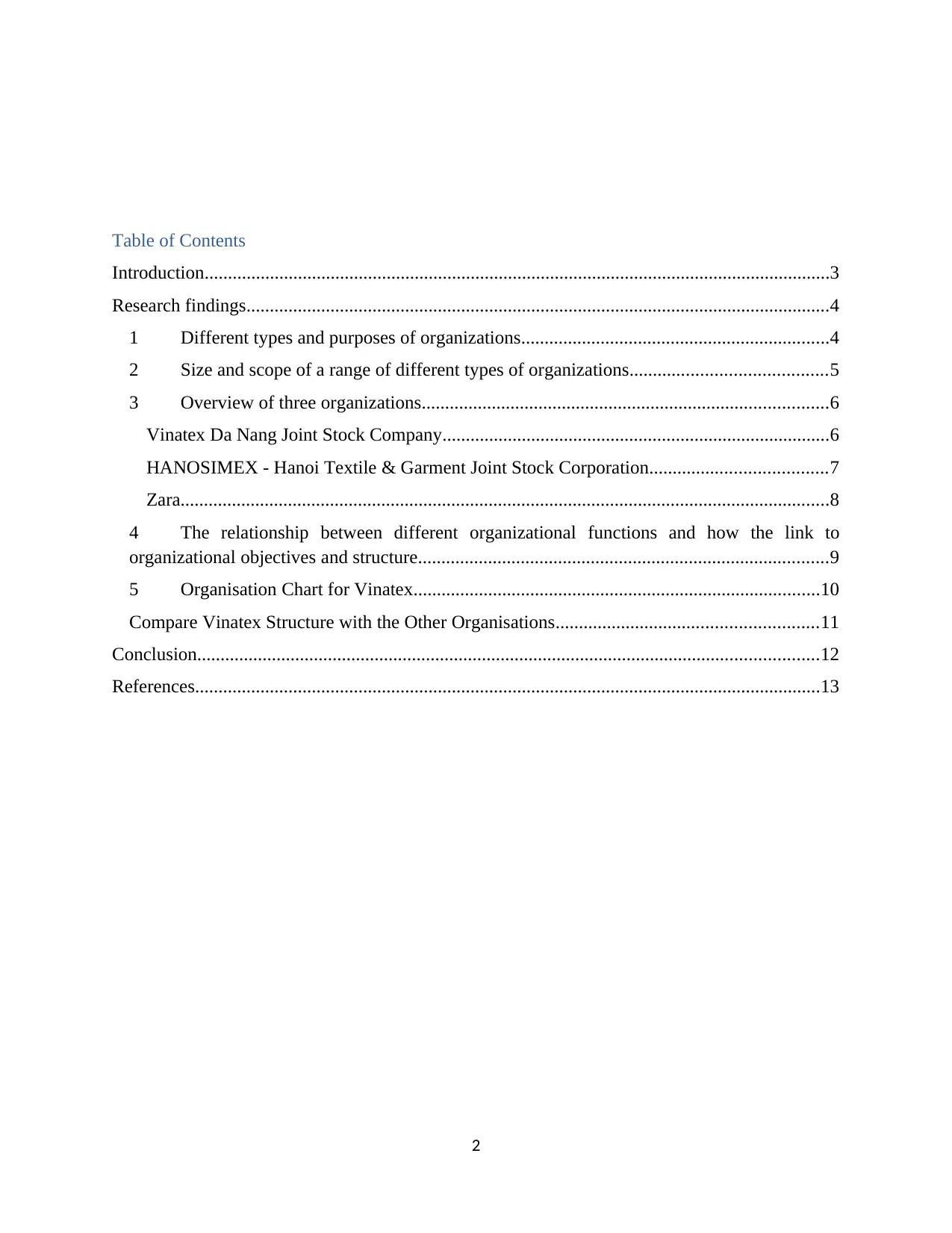
Table of Contents
Introduction......................................................................................................................................3
Research findings.............................................................................................................................4
1 Different types and purposes of organizations..................................................................4
2 Size and scope of a range of different types of organizations..........................................5
3 Overview of three organizations.......................................................................................6
Vinatex Da Nang Joint Stock Company...................................................................................6
HANOSIMEX - Hanoi Textile & Garment Joint Stock Corporation......................................7
Zara...........................................................................................................................................8
4 The relationship between different organizational functions and how the link to
organizational objectives and structure........................................................................................9
5 Organisation Chart for Vinatex.......................................................................................10
Compare Vinatex Structure with the Other Organisations........................................................11
Conclusion.....................................................................................................................................12
References......................................................................................................................................13
2
Introduction......................................................................................................................................3
Research findings.............................................................................................................................4
1 Different types and purposes of organizations..................................................................4
2 Size and scope of a range of different types of organizations..........................................5
3 Overview of three organizations.......................................................................................6
Vinatex Da Nang Joint Stock Company...................................................................................6
HANOSIMEX - Hanoi Textile & Garment Joint Stock Corporation......................................7
Zara...........................................................................................................................................8
4 The relationship between different organizational functions and how the link to
organizational objectives and structure........................................................................................9
5 Organisation Chart for Vinatex.......................................................................................10
Compare Vinatex Structure with the Other Organisations........................................................11
Conclusion.....................................................................................................................................12
References......................................................................................................................................13
2
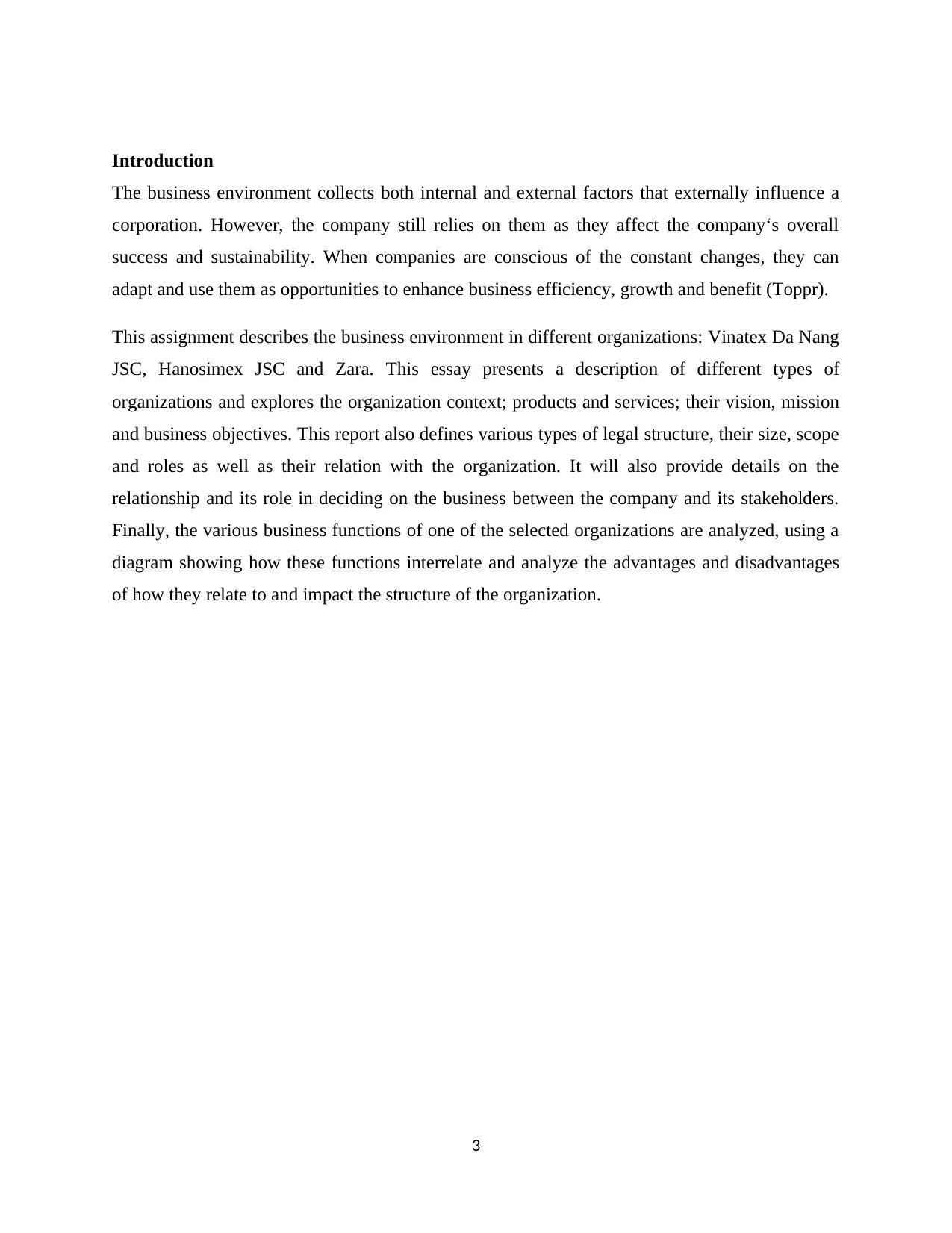
Introduction
The business environment collects both internal and external factors that externally influence a
corporation. However, the company still relies on them as they affect the company‘s overall
success and sustainability. When companies are conscious of the constant changes, they can
adapt and use them as opportunities to enhance business efficiency, growth and benefit (Toppr).
This assignment describes the business environment in different organizations: Vinatex Da Nang
JSC, Hanosimex JSC and Zara. This essay presents a description of different types of
organizations and explores the organization context; products and services; their vision, mission
and business objectives. This report also defines various types of legal structure, their size, scope
and roles as well as their relation with the organization. It will also provide details on the
relationship and its role in deciding on the business between the company and its stakeholders.
Finally, the various business functions of one of the selected organizations are analyzed, using a
diagram showing how these functions interrelate and analyze the advantages and disadvantages
of how they relate to and impact the structure of the organization.
3
The business environment collects both internal and external factors that externally influence a
corporation. However, the company still relies on them as they affect the company‘s overall
success and sustainability. When companies are conscious of the constant changes, they can
adapt and use them as opportunities to enhance business efficiency, growth and benefit (Toppr).
This assignment describes the business environment in different organizations: Vinatex Da Nang
JSC, Hanosimex JSC and Zara. This essay presents a description of different types of
organizations and explores the organization context; products and services; their vision, mission
and business objectives. This report also defines various types of legal structure, their size, scope
and roles as well as their relation with the organization. It will also provide details on the
relationship and its role in deciding on the business between the company and its stakeholders.
Finally, the various business functions of one of the selected organizations are analyzed, using a
diagram showing how these functions interrelate and analyze the advantages and disadvantages
of how they relate to and impact the structure of the organization.
3
⊘ This is a preview!⊘
Do you want full access?
Subscribe today to unlock all pages.

Trusted by 1+ million students worldwide
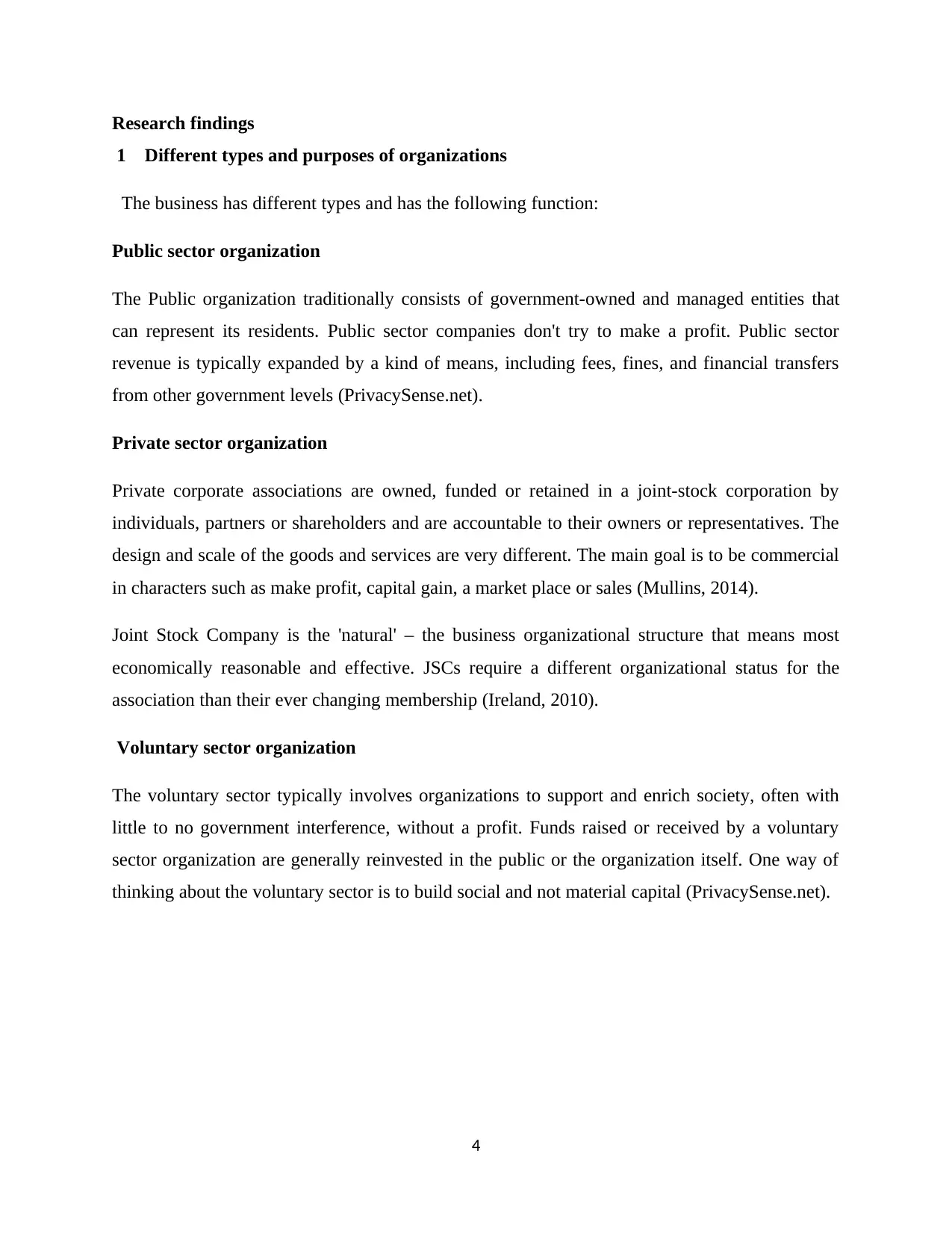
Research findings
1 Different types and purposes of organizations
The business has different types and has the following function:
Public sector organization
The Public organization traditionally consists of government-owned and managed entities that
can represent its residents. Public sector companies don't try to make a profit. Public sector
revenue is typically expanded by a kind of means, including fees, fines, and financial transfers
from other government levels (PrivacySense.net).
Private sector organization
Private corporate associations are owned, funded or retained in a joint-stock corporation by
individuals, partners or shareholders and are accountable to their owners or representatives. The
design and scale of the goods and services are very different. The main goal is to be commercial
in characters such as make profit, capital gain, a market place or sales (Mullins, 2014).
Joint Stock Company is the 'natural' – the business organizational structure that means most
economically reasonable and effective. JSCs require a different organizational status for the
association than their ever changing membership (Ireland, 2010).
Voluntary sector organization
The voluntary sector typically involves organizations to support and enrich society, often with
little to no government interference, without a profit. Funds raised or received by a voluntary
sector organization are generally reinvested in the public or the organization itself. One way of
thinking about the voluntary sector is to build social and not material capital (PrivacySense.net).
4
1 Different types and purposes of organizations
The business has different types and has the following function:
Public sector organization
The Public organization traditionally consists of government-owned and managed entities that
can represent its residents. Public sector companies don't try to make a profit. Public sector
revenue is typically expanded by a kind of means, including fees, fines, and financial transfers
from other government levels (PrivacySense.net).
Private sector organization
Private corporate associations are owned, funded or retained in a joint-stock corporation by
individuals, partners or shareholders and are accountable to their owners or representatives. The
design and scale of the goods and services are very different. The main goal is to be commercial
in characters such as make profit, capital gain, a market place or sales (Mullins, 2014).
Joint Stock Company is the 'natural' – the business organizational structure that means most
economically reasonable and effective. JSCs require a different organizational status for the
association than their ever changing membership (Ireland, 2010).
Voluntary sector organization
The voluntary sector typically involves organizations to support and enrich society, often with
little to no government interference, without a profit. Funds raised or received by a voluntary
sector organization are generally reinvested in the public or the organization itself. One way of
thinking about the voluntary sector is to build social and not material capital (PrivacySense.net).
4
Paraphrase This Document
Need a fresh take? Get an instant paraphrase of this document with our AI Paraphraser
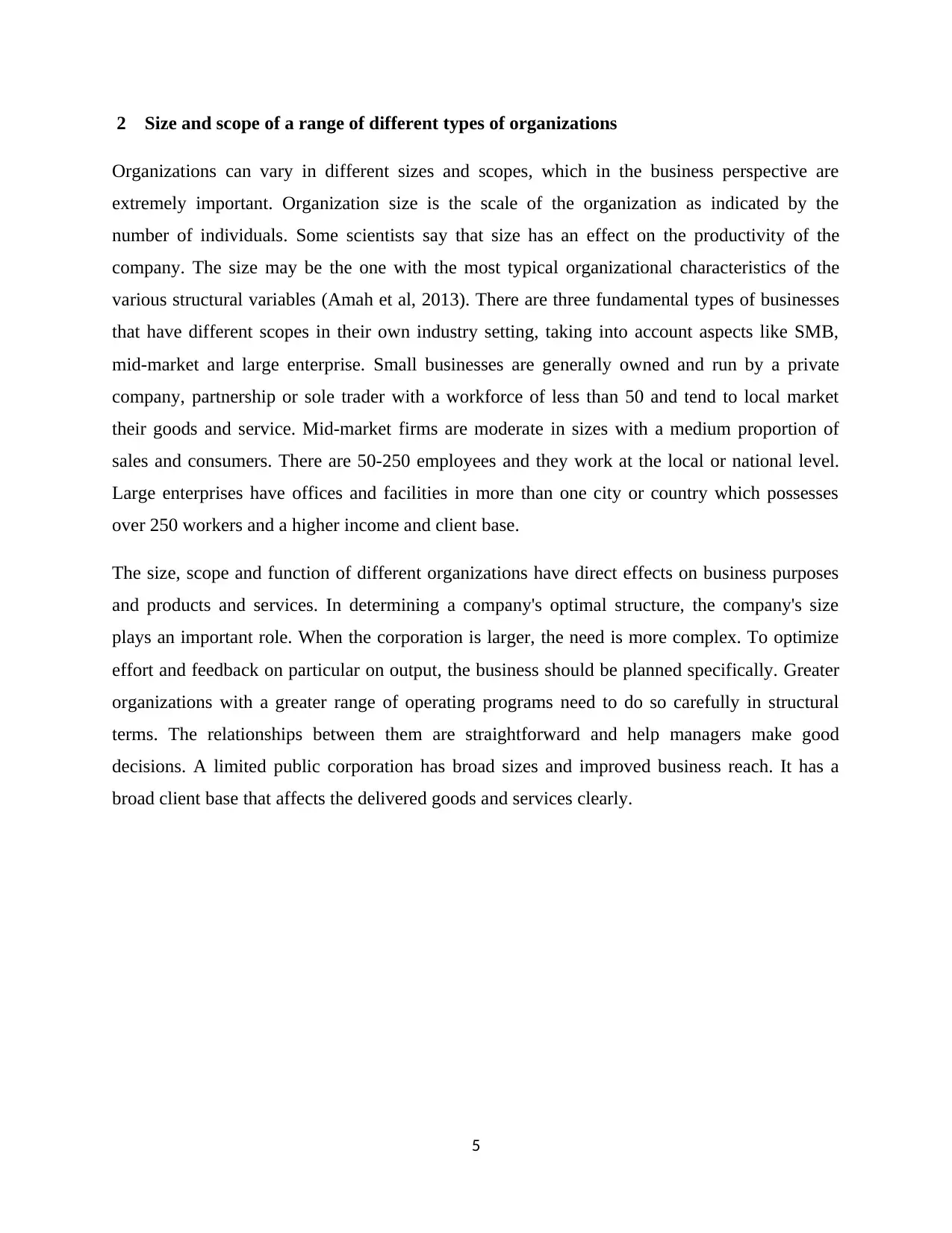
2 Size and scope of a range of different types of organizations
Organizations can vary in different sizes and scopes, which in the business perspective are
extremely important. Organization size is the scale of the organization as indicated by the
number of individuals. Some scientists say that size has an effect on the productivity of the
company. The size may be the one with the most typical organizational characteristics of the
various structural variables (Amah et al, 2013). There are three fundamental types of businesses
that have different scopes in their own industry setting, taking into account aspects like SMB,
mid-market and large enterprise. Small businesses are generally owned and run by a private
company, partnership or sole trader with a workforce of less than 50 and tend to local market
their goods and service. Mid-market firms are moderate in sizes with a medium proportion of
sales and consumers. There are 50-250 employees and they work at the local or national level.
Large enterprises have offices and facilities in more than one city or country which possesses
over 250 workers and a higher income and client base.
The size, scope and function of different organizations have direct effects on business purposes
and products and services. In determining a company's optimal structure, the company's size
plays an important role. When the corporation is larger, the need is more complex. To optimize
effort and feedback on particular on output, the business should be planned specifically. Greater
organizations with a greater range of operating programs need to do so carefully in structural
terms. The relationships between them are straightforward and help managers make good
decisions. A limited public corporation has broad sizes and improved business reach. It has a
broad client base that affects the delivered goods and services clearly.
5
Organizations can vary in different sizes and scopes, which in the business perspective are
extremely important. Organization size is the scale of the organization as indicated by the
number of individuals. Some scientists say that size has an effect on the productivity of the
company. The size may be the one with the most typical organizational characteristics of the
various structural variables (Amah et al, 2013). There are three fundamental types of businesses
that have different scopes in their own industry setting, taking into account aspects like SMB,
mid-market and large enterprise. Small businesses are generally owned and run by a private
company, partnership or sole trader with a workforce of less than 50 and tend to local market
their goods and service. Mid-market firms are moderate in sizes with a medium proportion of
sales and consumers. There are 50-250 employees and they work at the local or national level.
Large enterprises have offices and facilities in more than one city or country which possesses
over 250 workers and a higher income and client base.
The size, scope and function of different organizations have direct effects on business purposes
and products and services. In determining a company's optimal structure, the company's size
plays an important role. When the corporation is larger, the need is more complex. To optimize
effort and feedback on particular on output, the business should be planned specifically. Greater
organizations with a greater range of operating programs need to do so carefully in structural
terms. The relationships between them are straightforward and help managers make good
decisions. A limited public corporation has broad sizes and improved business reach. It has a
broad client base that affects the delivered goods and services clearly.
5
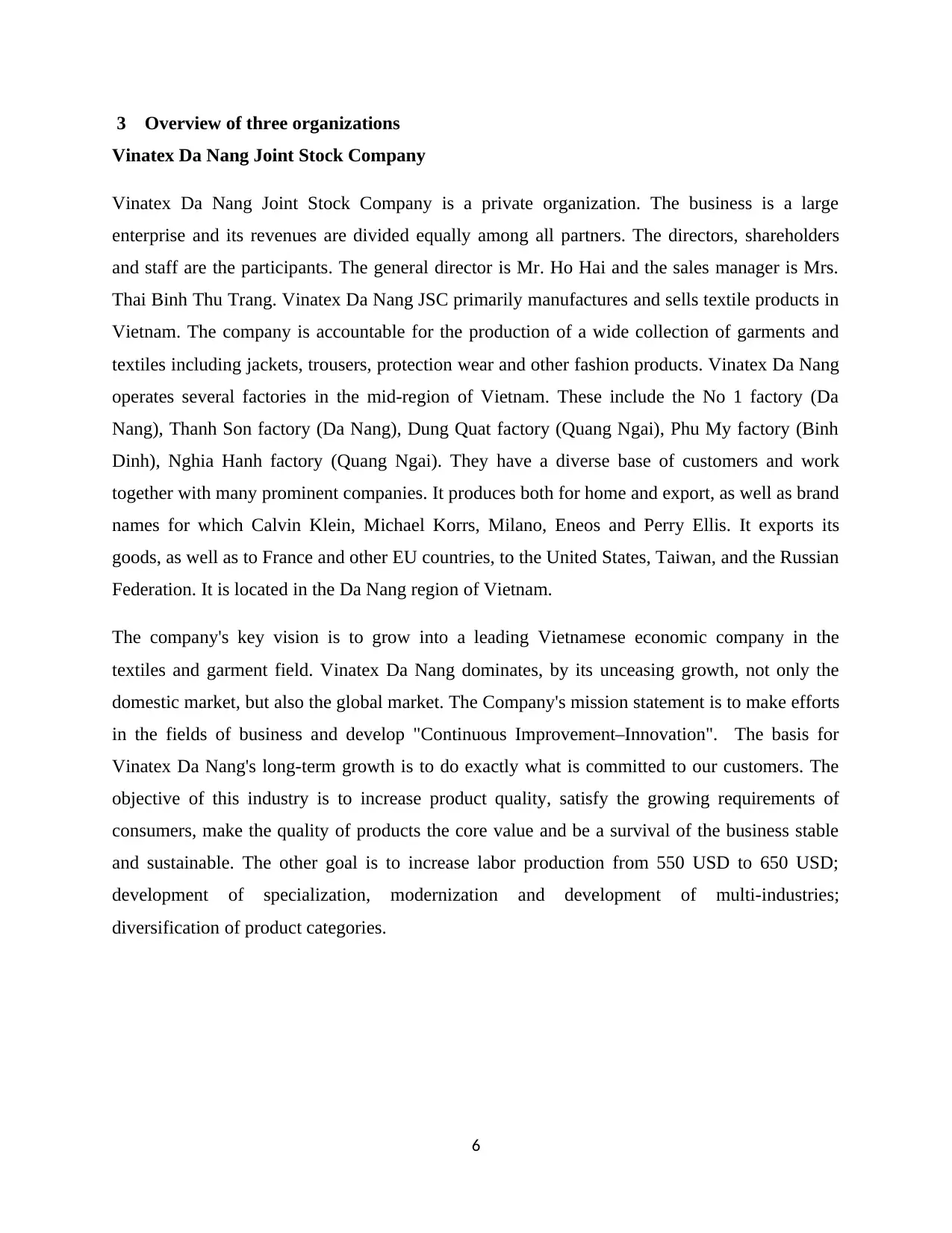
3 Overview of three organizations
Vinatex Da Nang Joint Stock Company
Vinatex Da Nang Joint Stock Company is a private organization. The business is a large
enterprise and its revenues are divided equally among all partners. The directors, shareholders
and staff are the participants. The general director is Mr. Ho Hai and the sales manager is Mrs.
Thai Binh Thu Trang. Vinatex Da Nang JSC primarily manufactures and sells textile products in
Vietnam. The company is accountable for the production of a wide collection of garments and
textiles including jackets, trousers, protection wear and other fashion products. Vinatex Da Nang
operates several factories in the mid-region of Vietnam. These include the No 1 factory (Da
Nang), Thanh Son factory (Da Nang), Dung Quat factory (Quang Ngai), Phu My factory (Binh
Dinh), Nghia Hanh factory (Quang Ngai). They have a diverse base of customers and work
together with many prominent companies. It produces both for home and export, as well as brand
names for which Calvin Klein, Michael Korrs, Milano, Eneos and Perry Ellis. It exports its
goods, as well as to France and other EU countries, to the United States, Taiwan, and the Russian
Federation. It is located in the Da Nang region of Vietnam.
The company's key vision is to grow into a leading Vietnamese economic company in the
textiles and garment field. Vinatex Da Nang dominates, by its unceasing growth, not only the
domestic market, but also the global market. The Company's mission statement is to make efforts
in the fields of business and develop "Continuous Improvement–Innovation". The basis for
Vinatex Da Nang's long-term growth is to do exactly what is committed to our customers. The
objective of this industry is to increase product quality, satisfy the growing requirements of
consumers, make the quality of products the core value and be a survival of the business stable
and sustainable. The other goal is to increase labor production from 550 USD to 650 USD;
development of specialization, modernization and development of multi-industries;
diversification of product categories.
6
Vinatex Da Nang Joint Stock Company
Vinatex Da Nang Joint Stock Company is a private organization. The business is a large
enterprise and its revenues are divided equally among all partners. The directors, shareholders
and staff are the participants. The general director is Mr. Ho Hai and the sales manager is Mrs.
Thai Binh Thu Trang. Vinatex Da Nang JSC primarily manufactures and sells textile products in
Vietnam. The company is accountable for the production of a wide collection of garments and
textiles including jackets, trousers, protection wear and other fashion products. Vinatex Da Nang
operates several factories in the mid-region of Vietnam. These include the No 1 factory (Da
Nang), Thanh Son factory (Da Nang), Dung Quat factory (Quang Ngai), Phu My factory (Binh
Dinh), Nghia Hanh factory (Quang Ngai). They have a diverse base of customers and work
together with many prominent companies. It produces both for home and export, as well as brand
names for which Calvin Klein, Michael Korrs, Milano, Eneos and Perry Ellis. It exports its
goods, as well as to France and other EU countries, to the United States, Taiwan, and the Russian
Federation. It is located in the Da Nang region of Vietnam.
The company's key vision is to grow into a leading Vietnamese economic company in the
textiles and garment field. Vinatex Da Nang dominates, by its unceasing growth, not only the
domestic market, but also the global market. The Company's mission statement is to make efforts
in the fields of business and develop "Continuous Improvement–Innovation". The basis for
Vinatex Da Nang's long-term growth is to do exactly what is committed to our customers. The
objective of this industry is to increase product quality, satisfy the growing requirements of
consumers, make the quality of products the core value and be a survival of the business stable
and sustainable. The other goal is to increase labor production from 550 USD to 650 USD;
development of specialization, modernization and development of multi-industries;
diversification of product categories.
6
⊘ This is a preview!⊘
Do you want full access?
Subscribe today to unlock all pages.

Trusted by 1+ million students worldwide
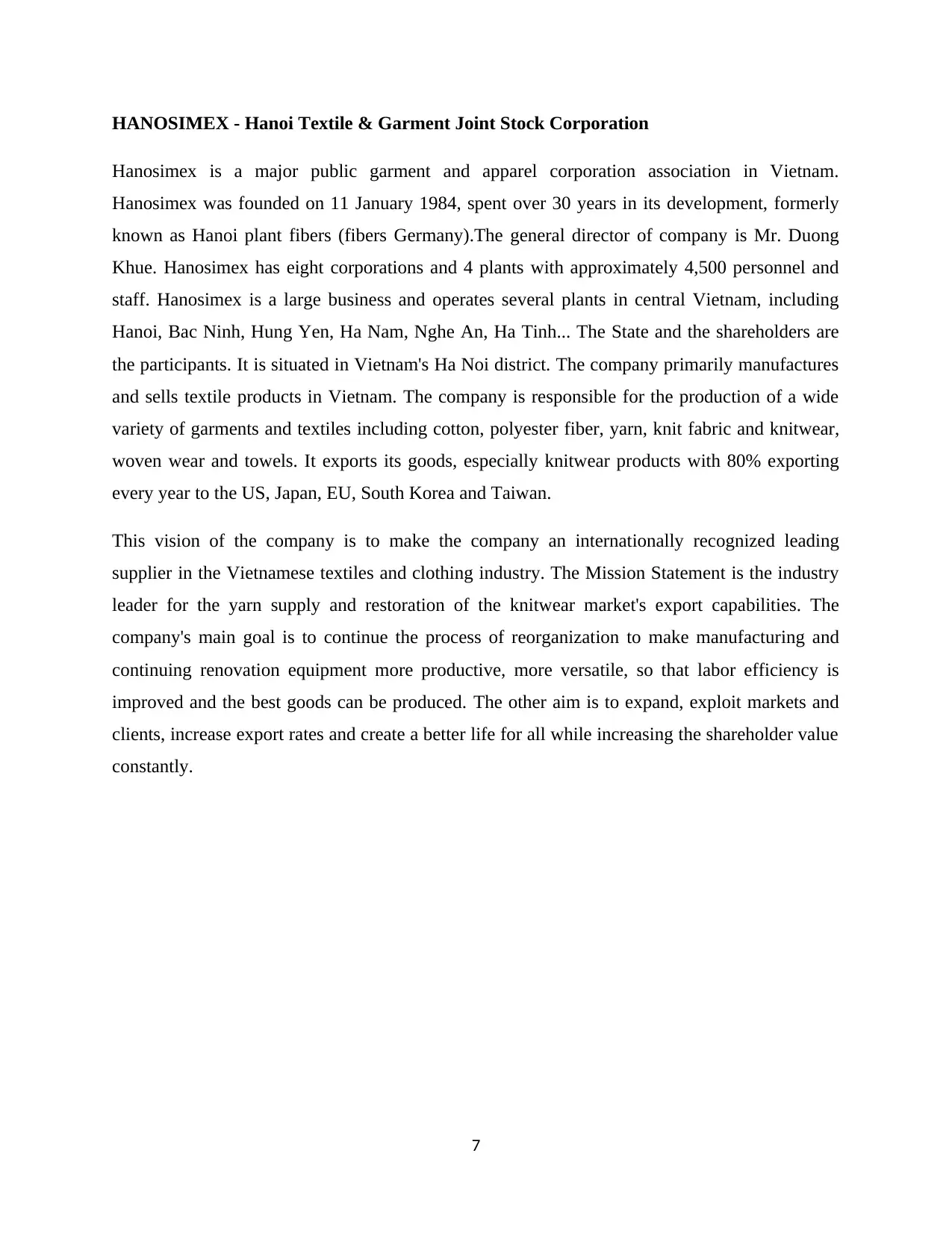
HANOSIMEX - Hanoi Textile & Garment Joint Stock Corporation
Hanosimex is a major public garment and apparel corporation association in Vietnam.
Hanosimex was founded on 11 January 1984, spent over 30 years in its development, formerly
known as Hanoi plant fibers (fibers Germany).The general director of company is Mr. Duong
Khue. Hanosimex has eight corporations and 4 plants with approximately 4,500 personnel and
staff. Hanosimex is a large business and operates several plants in central Vietnam, including
Hanoi, Bac Ninh, Hung Yen, Ha Nam, Nghe An, Ha Tinh... The State and the shareholders are
the participants. It is situated in Vietnam's Ha Noi district. The company primarily manufactures
and sells textile products in Vietnam. The company is responsible for the production of a wide
variety of garments and textiles including cotton, polyester fiber, yarn, knit fabric and knitwear,
woven wear and towels. It exports its goods, especially knitwear products with 80% exporting
every year to the US, Japan, EU, South Korea and Taiwan.
This vision of the company is to make the company an internationally recognized leading
supplier in the Vietnamese textiles and clothing industry. The Mission Statement is the industry
leader for the yarn supply and restoration of the knitwear market's export capabilities. The
company's main goal is to continue the process of reorganization to make manufacturing and
continuing renovation equipment more productive, more versatile, so that labor efficiency is
improved and the best goods can be produced. The other aim is to expand, exploit markets and
clients, increase export rates and create a better life for all while increasing the shareholder value
constantly.
7
Hanosimex is a major public garment and apparel corporation association in Vietnam.
Hanosimex was founded on 11 January 1984, spent over 30 years in its development, formerly
known as Hanoi plant fibers (fibers Germany).The general director of company is Mr. Duong
Khue. Hanosimex has eight corporations and 4 plants with approximately 4,500 personnel and
staff. Hanosimex is a large business and operates several plants in central Vietnam, including
Hanoi, Bac Ninh, Hung Yen, Ha Nam, Nghe An, Ha Tinh... The State and the shareholders are
the participants. It is situated in Vietnam's Ha Noi district. The company primarily manufactures
and sells textile products in Vietnam. The company is responsible for the production of a wide
variety of garments and textiles including cotton, polyester fiber, yarn, knit fabric and knitwear,
woven wear and towels. It exports its goods, especially knitwear products with 80% exporting
every year to the US, Japan, EU, South Korea and Taiwan.
This vision of the company is to make the company an internationally recognized leading
supplier in the Vietnamese textiles and clothing industry. The Mission Statement is the industry
leader for the yarn supply and restoration of the knitwear market's export capabilities. The
company's main goal is to continue the process of reorganization to make manufacturing and
continuing renovation equipment more productive, more versatile, so that labor efficiency is
improved and the best goods can be produced. The other aim is to expand, exploit markets and
clients, increase export rates and create a better life for all while increasing the shareholder value
constantly.
7
Paraphrase This Document
Need a fresh take? Get an instant paraphrase of this document with our AI Paraphraser
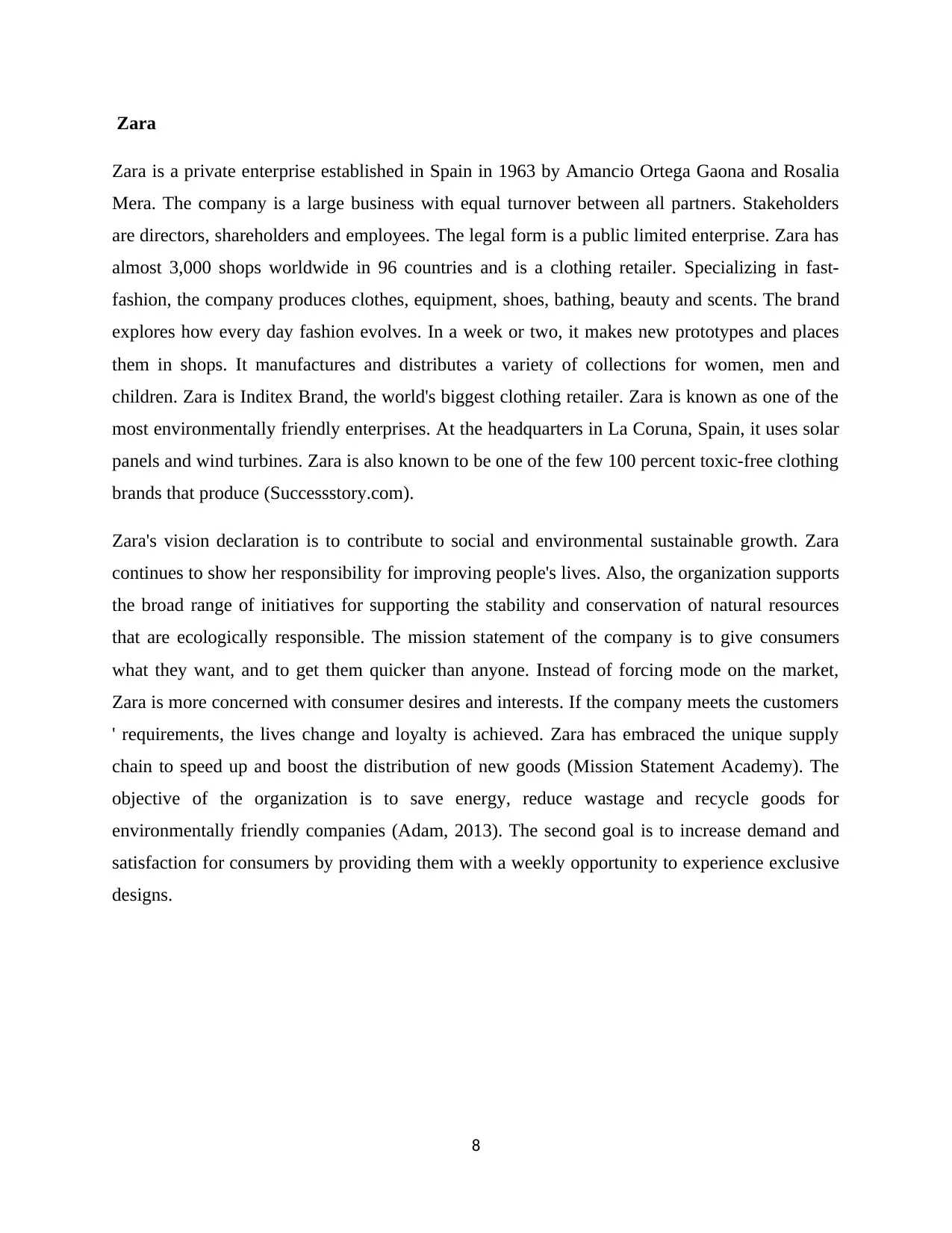
Zara
Zara is a private enterprise established in Spain in 1963 by Amancio Ortega Gaona and Rosalia
Mera. The company is a large business with equal turnover between all partners. Stakeholders
are directors, shareholders and employees. The legal form is a public limited enterprise. Zara has
almost 3,000 shops worldwide in 96 countries and is a clothing retailer. Specializing in fast-
fashion, the company produces clothes, equipment, shoes, bathing, beauty and scents. The brand
explores how every day fashion evolves. In a week or two, it makes new prototypes and places
them in shops. It manufactures and distributes a variety of collections for women, men and
children. Zara is Inditex Brand, the world's biggest clothing retailer. Zara is known as one of the
most environmentally friendly enterprises. At the headquarters in La Coruna, Spain, it uses solar
panels and wind turbines. Zara is also known to be one of the few 100 percent toxic-free clothing
brands that produce (Successstory.com).
Zara's vision declaration is to contribute to social and environmental sustainable growth. Zara
continues to show her responsibility for improving people's lives. Also, the organization supports
the broad range of initiatives for supporting the stability and conservation of natural resources
that are ecologically responsible. The mission statement of the company is to give consumers
what they want, and to get them quicker than anyone. Instead of forcing mode on the market,
Zara is more concerned with consumer desires and interests. If the company meets the customers
' requirements, the lives change and loyalty is achieved. Zara has embraced the unique supply
chain to speed up and boost the distribution of new goods (Mission Statement Academy). The
objective of the organization is to save energy, reduce wastage and recycle goods for
environmentally friendly companies (Adam, 2013). The second goal is to increase demand and
satisfaction for consumers by providing them with a weekly opportunity to experience exclusive
designs.
8
Zara is a private enterprise established in Spain in 1963 by Amancio Ortega Gaona and Rosalia
Mera. The company is a large business with equal turnover between all partners. Stakeholders
are directors, shareholders and employees. The legal form is a public limited enterprise. Zara has
almost 3,000 shops worldwide in 96 countries and is a clothing retailer. Specializing in fast-
fashion, the company produces clothes, equipment, shoes, bathing, beauty and scents. The brand
explores how every day fashion evolves. In a week or two, it makes new prototypes and places
them in shops. It manufactures and distributes a variety of collections for women, men and
children. Zara is Inditex Brand, the world's biggest clothing retailer. Zara is known as one of the
most environmentally friendly enterprises. At the headquarters in La Coruna, Spain, it uses solar
panels and wind turbines. Zara is also known to be one of the few 100 percent toxic-free clothing
brands that produce (Successstory.com).
Zara's vision declaration is to contribute to social and environmental sustainable growth. Zara
continues to show her responsibility for improving people's lives. Also, the organization supports
the broad range of initiatives for supporting the stability and conservation of natural resources
that are ecologically responsible. The mission statement of the company is to give consumers
what they want, and to get them quicker than anyone. Instead of forcing mode on the market,
Zara is more concerned with consumer desires and interests. If the company meets the customers
' requirements, the lives change and loyalty is achieved. Zara has embraced the unique supply
chain to speed up and boost the distribution of new goods (Mission Statement Academy). The
objective of the organization is to save energy, reduce wastage and recycle goods for
environmentally friendly companies (Adam, 2013). The second goal is to increase demand and
satisfaction for consumers by providing them with a weekly opportunity to experience exclusive
designs.
8
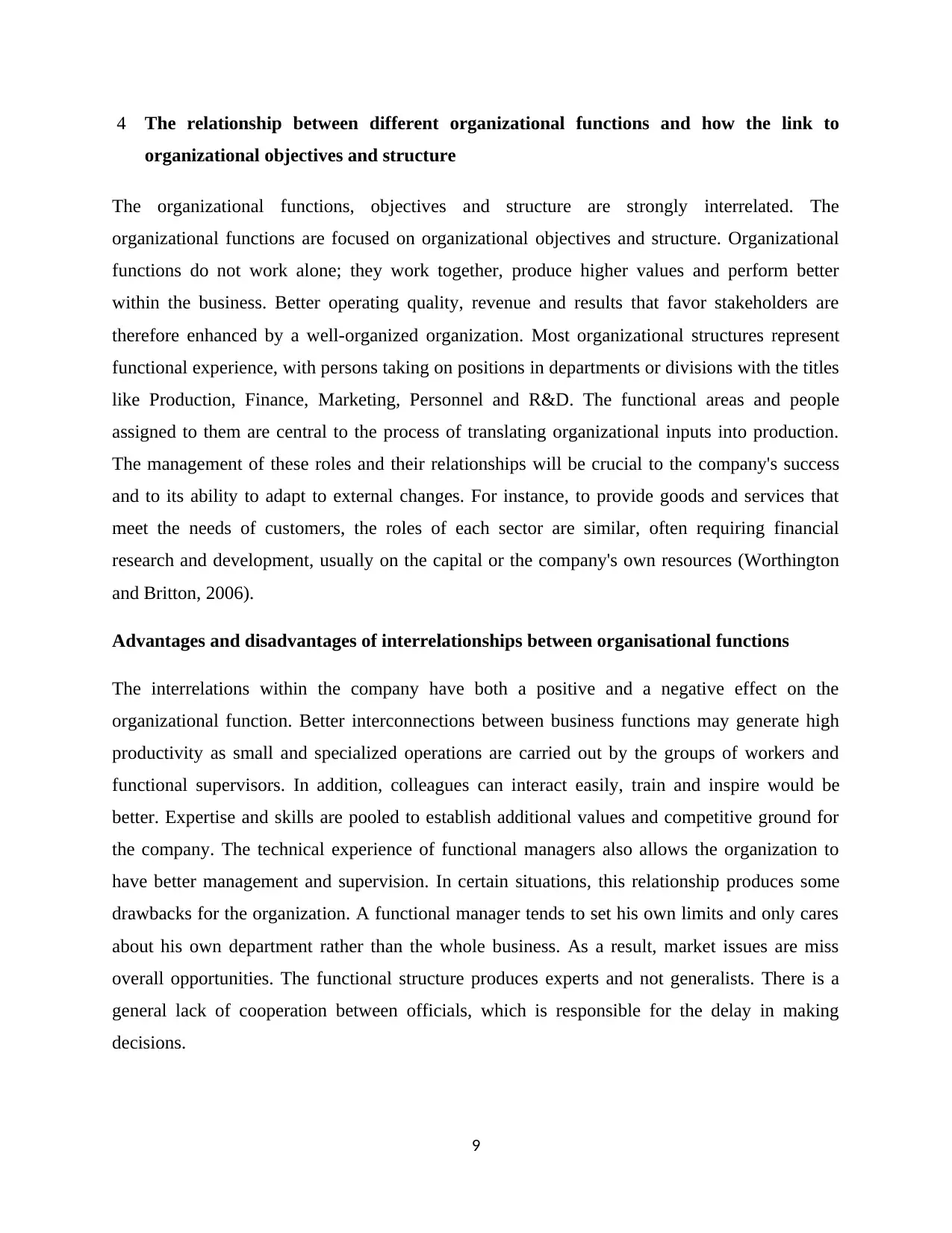
4 The relationship between different organizational functions and how the link to
organizational objectives and structure
The organizational functions, objectives and structure are strongly interrelated. The
organizational functions are focused on organizational objectives and structure. Organizational
functions do not work alone; they work together, produce higher values and perform better
within the business. Better operating quality, revenue and results that favor stakeholders are
therefore enhanced by a well-organized organization. Most organizational structures represent
functional experience, with persons taking on positions in departments or divisions with the titles
like Production, Finance, Marketing, Personnel and R&D. The functional areas and people
assigned to them are central to the process of translating organizational inputs into production.
The management of these roles and their relationships will be crucial to the company's success
and to its ability to adapt to external changes. For instance, to provide goods and services that
meet the needs of customers, the roles of each sector are similar, often requiring financial
research and development, usually on the capital or the company's own resources (Worthington
and Britton, 2006).
Advantages and disadvantages of interrelationships between organisational functions
The interrelations within the company have both a positive and a negative effect on the
organizational function. Better interconnections between business functions may generate high
productivity as small and specialized operations are carried out by the groups of workers and
functional supervisors. In addition, colleagues can interact easily, train and inspire would be
better. Expertise and skills are pooled to establish additional values and competitive ground for
the company. The technical experience of functional managers also allows the organization to
have better management and supervision. In certain situations, this relationship produces some
drawbacks for the organization. A functional manager tends to set his own limits and only cares
about his own department rather than the whole business. As a result, market issues are miss
overall opportunities. The functional structure produces experts and not generalists. There is a
general lack of cooperation between officials, which is responsible for the delay in making
decisions.
9
organizational objectives and structure
The organizational functions, objectives and structure are strongly interrelated. The
organizational functions are focused on organizational objectives and structure. Organizational
functions do not work alone; they work together, produce higher values and perform better
within the business. Better operating quality, revenue and results that favor stakeholders are
therefore enhanced by a well-organized organization. Most organizational structures represent
functional experience, with persons taking on positions in departments or divisions with the titles
like Production, Finance, Marketing, Personnel and R&D. The functional areas and people
assigned to them are central to the process of translating organizational inputs into production.
The management of these roles and their relationships will be crucial to the company's success
and to its ability to adapt to external changes. For instance, to provide goods and services that
meet the needs of customers, the roles of each sector are similar, often requiring financial
research and development, usually on the capital or the company's own resources (Worthington
and Britton, 2006).
Advantages and disadvantages of interrelationships between organisational functions
The interrelations within the company have both a positive and a negative effect on the
organizational function. Better interconnections between business functions may generate high
productivity as small and specialized operations are carried out by the groups of workers and
functional supervisors. In addition, colleagues can interact easily, train and inspire would be
better. Expertise and skills are pooled to establish additional values and competitive ground for
the company. The technical experience of functional managers also allows the organization to
have better management and supervision. In certain situations, this relationship produces some
drawbacks for the organization. A functional manager tends to set his own limits and only cares
about his own department rather than the whole business. As a result, market issues are miss
overall opportunities. The functional structure produces experts and not generalists. There is a
general lack of cooperation between officials, which is responsible for the delay in making
decisions.
9
⊘ This is a preview!⊘
Do you want full access?
Subscribe today to unlock all pages.

Trusted by 1+ million students worldwide
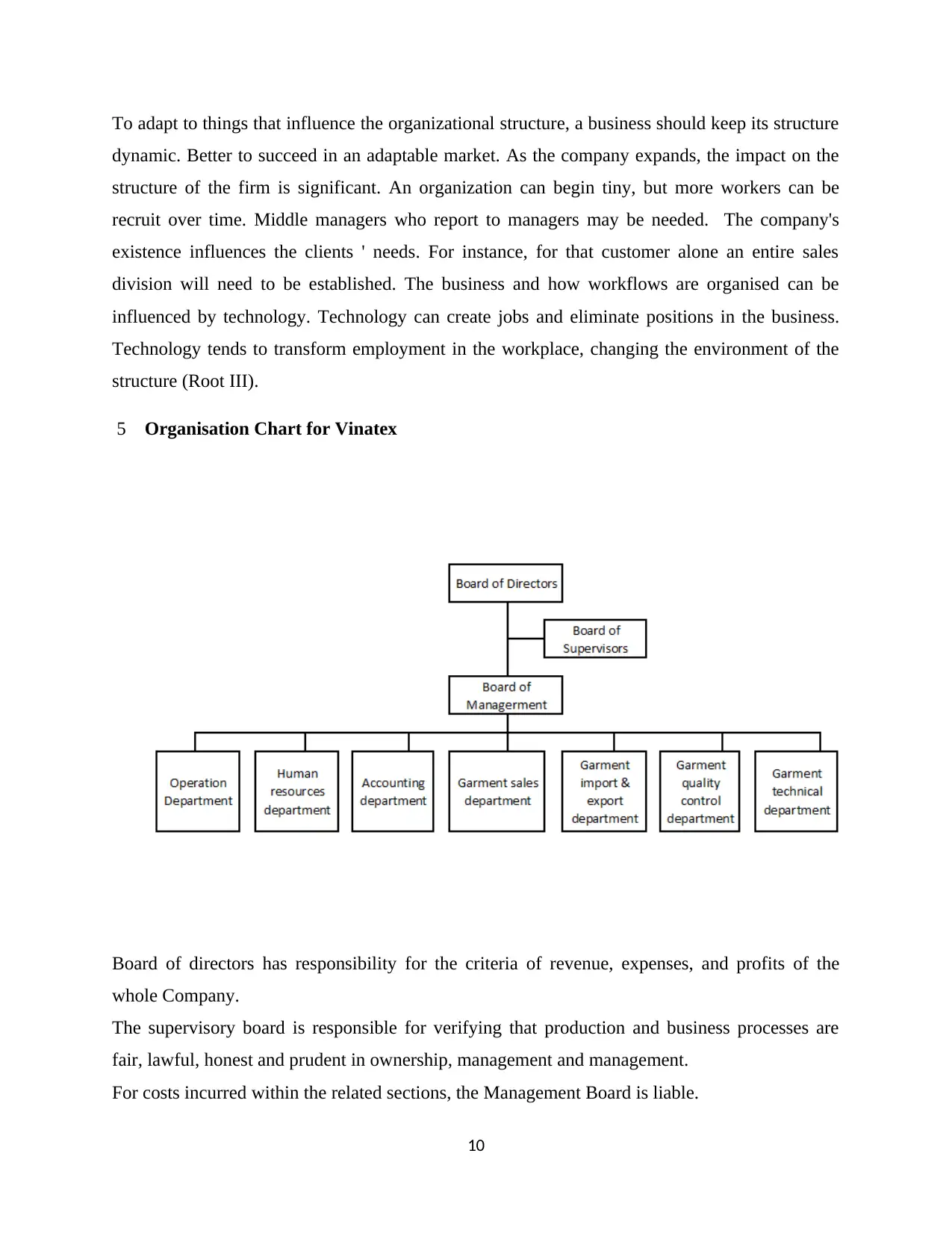
To adapt to things that influence the organizational structure, a business should keep its structure
dynamic. Better to succeed in an adaptable market. As the company expands, the impact on the
structure of the firm is significant. An organization can begin tiny, but more workers can be
recruit over time. Middle managers who report to managers may be needed. The company's
existence influences the clients ' needs. For instance, for that customer alone an entire sales
division will need to be established. The business and how workflows are organised can be
influenced by technology. Technology can create jobs and eliminate positions in the business.
Technology tends to transform employment in the workplace, changing the environment of the
structure (Root III).
5 Organisation Chart for Vinatex
Board of directors has responsibility for the criteria of revenue, expenses, and profits of the
whole Company.
The supervisory board is responsible for verifying that production and business processes are
fair, lawful, honest and prudent in ownership, management and management.
For costs incurred within the related sections, the Management Board is liable.
10
dynamic. Better to succeed in an adaptable market. As the company expands, the impact on the
structure of the firm is significant. An organization can begin tiny, but more workers can be
recruit over time. Middle managers who report to managers may be needed. The company's
existence influences the clients ' needs. For instance, for that customer alone an entire sales
division will need to be established. The business and how workflows are organised can be
influenced by technology. Technology can create jobs and eliminate positions in the business.
Technology tends to transform employment in the workplace, changing the environment of the
structure (Root III).
5 Organisation Chart for Vinatex
Board of directors has responsibility for the criteria of revenue, expenses, and profits of the
whole Company.
The supervisory board is responsible for verifying that production and business processes are
fair, lawful, honest and prudent in ownership, management and management.
For costs incurred within the related sections, the Management Board is liable.
10
Paraphrase This Document
Need a fresh take? Get an instant paraphrase of this document with our AI Paraphraser
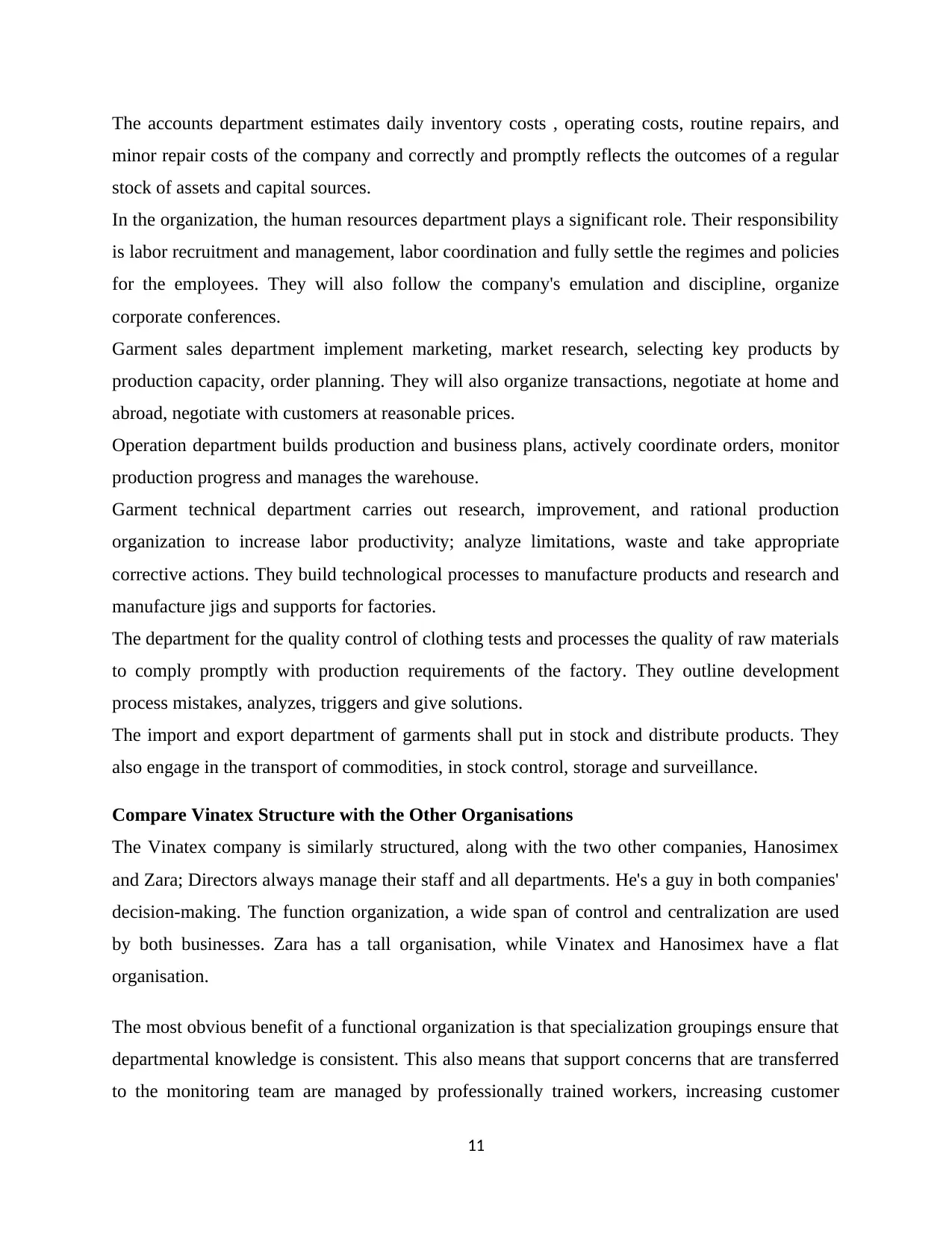
The accounts department estimates daily inventory costs , operating costs, routine repairs, and
minor repair costs of the company and correctly and promptly reflects the outcomes of a regular
stock of assets and capital sources.
In the organization, the human resources department plays a significant role. Their responsibility
is labor recruitment and management, labor coordination and fully settle the regimes and policies
for the employees. They will also follow the company's emulation and discipline, organize
corporate conferences.
Garment sales department implement marketing, market research, selecting key products by
production capacity, order planning. They will also organize transactions, negotiate at home and
abroad, negotiate with customers at reasonable prices.
Operation department builds production and business plans, actively coordinate orders, monitor
production progress and manages the warehouse.
Garment technical department carries out research, improvement, and rational production
organization to increase labor productivity; analyze limitations, waste and take appropriate
corrective actions. They build technological processes to manufacture products and research and
manufacture jigs and supports for factories.
The department for the quality control of clothing tests and processes the quality of raw materials
to comply promptly with production requirements of the factory. They outline development
process mistakes, analyzes, triggers and give solutions.
The import and export department of garments shall put in stock and distribute products. They
also engage in the transport of commodities, in stock control, storage and surveillance.
Compare Vinatex Structure with the Other Organisations
The Vinatex company is similarly structured, along with the two other companies, Hanosimex
and Zara; Directors always manage their staff and all departments. He's a guy in both companies'
decision-making. The function organization, a wide span of control and centralization are used
by both businesses. Zara has a tall organisation, while Vinatex and Hanosimex have a flat
organisation.
The most obvious benefit of a functional organization is that specialization groupings ensure that
departmental knowledge is consistent. This also means that support concerns that are transferred
to the monitoring team are managed by professionally trained workers, increasing customer
11
minor repair costs of the company and correctly and promptly reflects the outcomes of a regular
stock of assets and capital sources.
In the organization, the human resources department plays a significant role. Their responsibility
is labor recruitment and management, labor coordination and fully settle the regimes and policies
for the employees. They will also follow the company's emulation and discipline, organize
corporate conferences.
Garment sales department implement marketing, market research, selecting key products by
production capacity, order planning. They will also organize transactions, negotiate at home and
abroad, negotiate with customers at reasonable prices.
Operation department builds production and business plans, actively coordinate orders, monitor
production progress and manages the warehouse.
Garment technical department carries out research, improvement, and rational production
organization to increase labor productivity; analyze limitations, waste and take appropriate
corrective actions. They build technological processes to manufacture products and research and
manufacture jigs and supports for factories.
The department for the quality control of clothing tests and processes the quality of raw materials
to comply promptly with production requirements of the factory. They outline development
process mistakes, analyzes, triggers and give solutions.
The import and export department of garments shall put in stock and distribute products. They
also engage in the transport of commodities, in stock control, storage and surveillance.
Compare Vinatex Structure with the Other Organisations
The Vinatex company is similarly structured, along with the two other companies, Hanosimex
and Zara; Directors always manage their staff and all departments. He's a guy in both companies'
decision-making. The function organization, a wide span of control and centralization are used
by both businesses. Zara has a tall organisation, while Vinatex and Hanosimex have a flat
organisation.
The most obvious benefit of a functional organization is that specialization groupings ensure that
departmental knowledge is consistent. This also means that support concerns that are transferred
to the monitoring team are managed by professionally trained workers, increasing customer
11
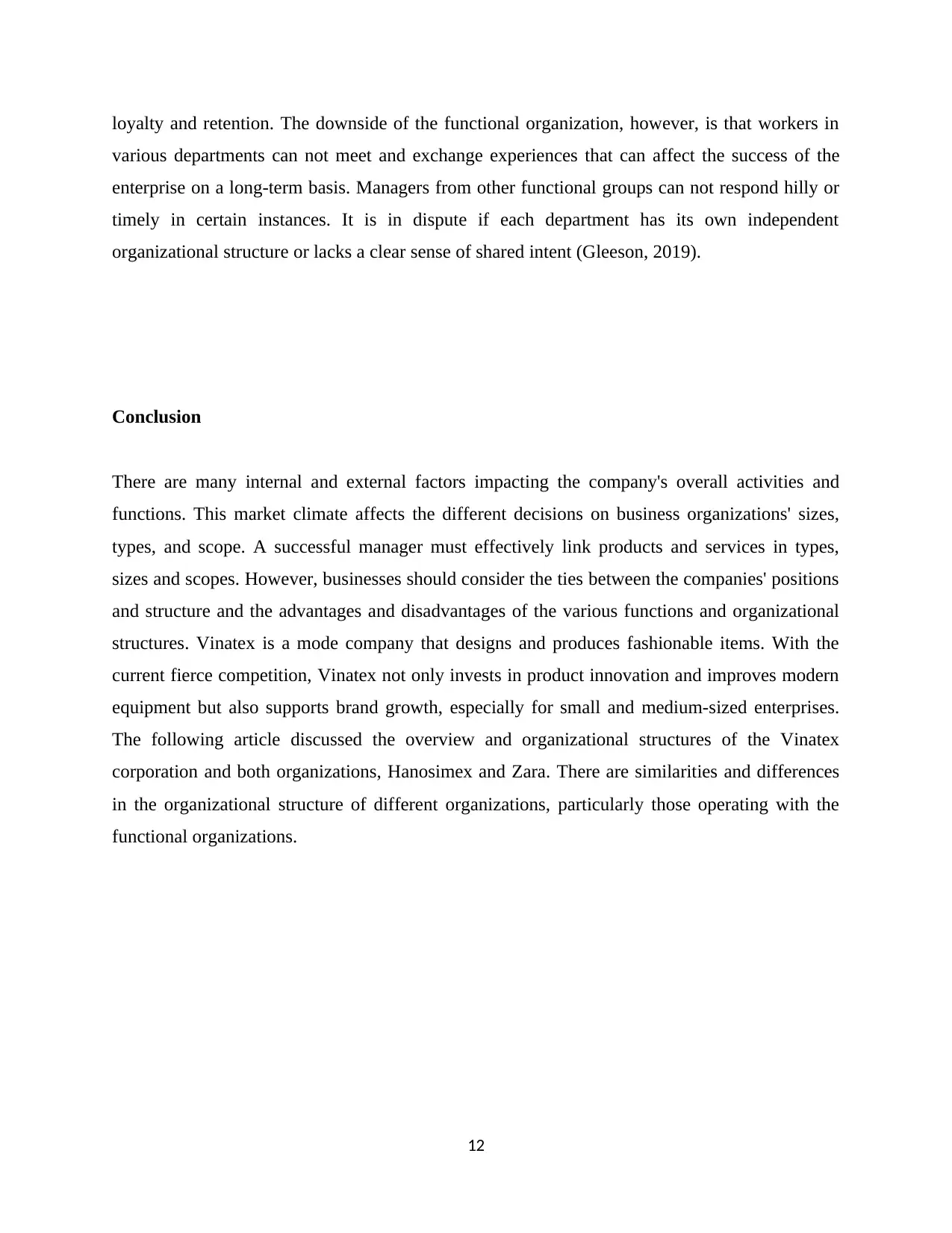
loyalty and retention. The downside of the functional organization, however, is that workers in
various departments can not meet and exchange experiences that can affect the success of the
enterprise on a long-term basis. Managers from other functional groups can not respond hilly or
timely in certain instances. It is in dispute if each department has its own independent
organizational structure or lacks a clear sense of shared intent (Gleeson, 2019).
Conclusion
There are many internal and external factors impacting the company's overall activities and
functions. This market climate affects the different decisions on business organizations' sizes,
types, and scope. A successful manager must effectively link products and services in types,
sizes and scopes. However, businesses should consider the ties between the companies' positions
and structure and the advantages and disadvantages of the various functions and organizational
structures. Vinatex is a mode company that designs and produces fashionable items. With the
current fierce competition, Vinatex not only invests in product innovation and improves modern
equipment but also supports brand growth, especially for small and medium-sized enterprises.
The following article discussed the overview and organizational structures of the Vinatex
corporation and both organizations, Hanosimex and Zara. There are similarities and differences
in the organizational structure of different organizations, particularly those operating with the
functional organizations.
12
various departments can not meet and exchange experiences that can affect the success of the
enterprise on a long-term basis. Managers from other functional groups can not respond hilly or
timely in certain instances. It is in dispute if each department has its own independent
organizational structure or lacks a clear sense of shared intent (Gleeson, 2019).
Conclusion
There are many internal and external factors impacting the company's overall activities and
functions. This market climate affects the different decisions on business organizations' sizes,
types, and scope. A successful manager must effectively link products and services in types,
sizes and scopes. However, businesses should consider the ties between the companies' positions
and structure and the advantages and disadvantages of the various functions and organizational
structures. Vinatex is a mode company that designs and produces fashionable items. With the
current fierce competition, Vinatex not only invests in product innovation and improves modern
equipment but also supports brand growth, especially for small and medium-sized enterprises.
The following article discussed the overview and organizational structures of the Vinatex
corporation and both organizations, Hanosimex and Zara. There are similarities and differences
in the organizational structure of different organizations, particularly those operating with the
functional organizations.
12
⊘ This is a preview!⊘
Do you want full access?
Subscribe today to unlock all pages.

Trusted by 1+ million students worldwide
1 out of 14
Related Documents
Your All-in-One AI-Powered Toolkit for Academic Success.
+13062052269
info@desklib.com
Available 24*7 on WhatsApp / Email
![[object Object]](/_next/static/media/star-bottom.7253800d.svg)
Unlock your academic potential
Copyright © 2020–2025 A2Z Services. All Rights Reserved. Developed and managed by ZUCOL.





